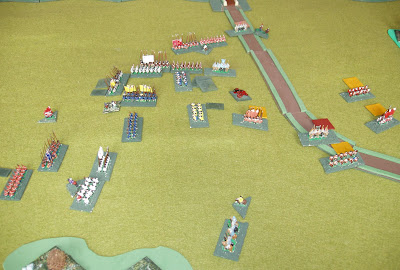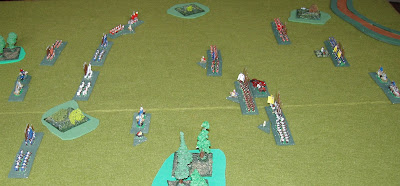Aside from Isabella of Austria, whose army is now firmly ensconced in London and who is starting to order the English armed forces about, the other major contender for the English throne at the moment is Arbella Stuart. She has marched from Derbyshire, defeating local resistance as she went, and is now in Buckinghamshire. She arrived there without resistance, then moved to Berkshire to join up with Edward Seymour, and then moved back to Buckinghamshire. Unfortunately, Seymour seems to be a bit unpopular, and this time the trained bands rallied against her.
This being the start of the Seventeenth Century, Arbella had to let Seymour command her army, rather than her own specially selected general. After all, she reckoned, it was his fault the locals had turned hostile, so he should sort it out at the point of a pike, as it were. Seymour, who has been languishing at the foot of the ‘most likely to be monarch’ table since the start of the game when he fumbled a GOOS roll, was not going to reject the chance to revive his fortunes.
The battlefield was ‘interesting’. The river and bridge on the far side were not really relevant except for slightly cramping Arbella’s left. The large patch of rough ground on the near side, too, was only really there to cramp the right, and the woods, though pretty, were a bit out of the field of interest. The real issues were the hills, upon which the trained bands are deployed. On the right, towards the river, is a ridge with nearly half the infantry. In the centre, there is a hill (I rolled a double six for location) with a load more, and the general. From Arbella / Edward’s point of view, this looked like a very tough nut to crack.
From the trained band’s side, it was a bit tricky too. The ridge and the central hill looked a bit too far apart for comfort, and as the trained bands had rolled a light horse and demi-lancer, as opposed to Arbella’s two demi-lancers, I was a little concerned about the salient by the bridge. Mind you, so was Edward, who put himself at the head of Arbella’s cavalry, positioned to trot into the gap.
The opening moves were very chess-like. Edward advanced the cavalry into the gap, having to make a detour to the river bank when the trained band demi-lancer threatened to flank him from the hill, and then he withdrew in the face of the advancing trained band infantry from the ridge. Arbella’s right had advanced into line with the rest of the foot, while her left had advanced to succour the cavalry and also threaten the central hill in the flank. As just noted, the trained band infantry from the ridge had decided that they were too far away from the flank of the central hill to protect the infantry there, and the light horse and left flank infantry were probing Arbella’s right.
At this point, Arbella was seriously concerned, as she could not see much future in storming the central hill, and there seemed to be no way of flanking it. Given Edward’s unpopularity, she hatched a scheme to negotiate with the trained band leadership. In her first go, she offered to let them go home in return for not disturbing them (or pardoning them when she became queen). This was rejected. Her second offer was to arrest Seymour as well, and this was accepted.
Whether Seymour was aware of Arbella’s treachery is something future historians will have to debate. Nevertheless, he was aware that something heroic was necessary for a future king of England. The advancing trained band foot gave him a fleeting opportunity.
Sensing the danger, the trained band general had rushed to his right flank by the bridge to recall the infantry there. He did so, but not quite far enough, and Edward’s cavalry was still to the flank, just about. Edward charged home, crushing the arquebusiers and routing them, who carried away their own pike and the general in the rush. Ouch.
While shaken, the trained bands did not give up. Edward’s cavalry had charged, so it was now pursuing. One base ran into some more pike and routed them, but the attached musketeers survived, albeit just. Edward’s demi-lancer base charged on, up the hill and hit the trained band cavalry. Trying to go uphill against formed cavalry was never going to go particularly well, and Edward was lucky to get away with his troops being recoiled, shaken, from the hill. He was able to withdraw them from the fray to reorganise. He also survived himself. Arbella’s thoughts about that are unrecorded.
The trained bands were still not giving up (good morale rolling) and even had some tempo points to spare. These they used to advance the infantry in the centre on Arbella’s men. Here, the trained band's luck ran out. Arbella’s musketeers shot away the wings of the trained band formation, while the trained band pike pushed back hers.
This meant that next turn, when Arbella was a bit more flush with tempo, she could turn her own lifeguard pike and some of the left wing foot onto the flanks of the trained band pike with almost inevitable consequences. At this, the trained bands had had more than enough, and the army routed.
That was a fascinating combat. I really did not think that Arbella would come out ahead on that, and her dumping of Seymour was the best I could make of the job. Seymour had other ideas, however, and seized a fleeting opportunity. In the photograph above, you can see the results of his labours fleeing behind the trained band lines, while the man himself is just finishing rallying his base of demi-lancers.
In terms of the campaign, of course, we now have a fairly solid alliance between Arbella and Seymour, while Arbella is still allied with Isabella. My guess is that interest will now switch north, to both of the invading Scots armies. One is in Durham, moving south, with the king, the other is aiming for the west coast route. One of the issues is whether Isabella can move the English army in Dublin to north-west England to oppose them.









































